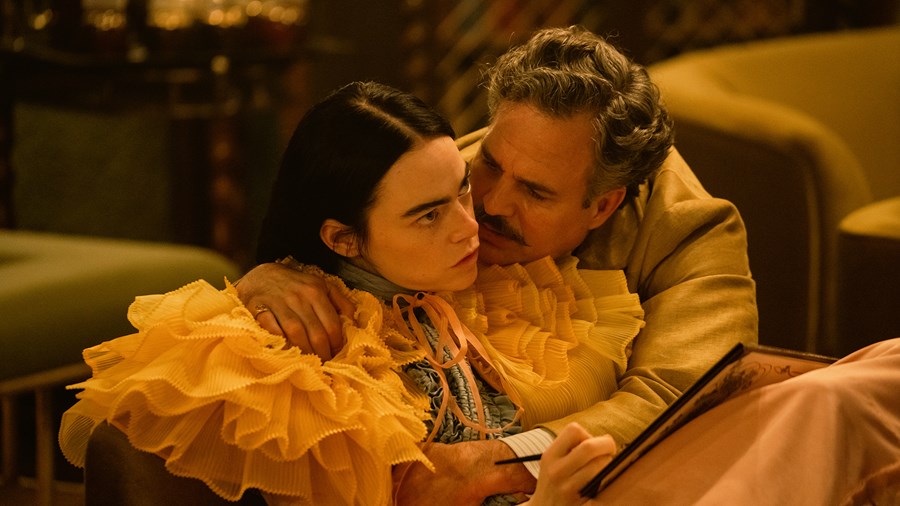Oscar-winning costume designer Holly Waddington speaks to Clarisse Loughrey about her role in creating a unique vision of the Victorian world for Yorgos Lanthimos’ period fantasy.

How might a woman, completely unburdened by society, choose to dress? It’s the electrifying question posed to costume designer Holly Waddington, tasked with imagining the radical, ever evolving wardrobe of Bella Baxter (Emma Stone), the Frankenstein’s monster running riot through Yorgos Lanthimos’ Poor Things. ‘She isn’t following any proper sartorial rules,’ Waddington explains. ‘There’s this strange simplicity to it. It’s all very wearable, very light, very comfortable. Nothing will pinch or hurt.’

Past Things (2023)
The film, set in a fantastical vision of the 19th century, sees Bella resurrected through unorthodox means by semi-mad scientist Dr Godwin Baxter (Willem Dafoe). Men assume she’ll be a blank canvas onto which they can project their own desires. Max McCandles (Ramy Youssef), doting and meek, seeks marriage. Duncan Wedderburn (Mark Ruffalo), drunk and arrogant, seeks seduction. She defies them all to create her own vision of womanhood. In sartorial terms, it means a life free from corsets, where suit jackets can be worn without suit skirts, and an outfit can be made up of nothing but bloomers, a dressing gown and socks right up to the knees.

Poor Things (2023)
Alisdair Gray’s source novel is set between 1881 and 1886, a period when women’s fashion featured, as Waddington notes, ‘very tight sleeves – and then all the information is around the hips and the bottom. I was excited about these shapes because I thought they were very phallic’. But, an early conversation with Lanthimos and one of the film’s production designers, Shona Heath, directed her attention a decade later, to the 1890s, when the sleeves began to engorge as the women’s suffrage movement gained momentum. ‘In the history of dress,’ Waddington says. ‘Women wear big shoulders at certain times, like in the 1980s, the 1940s, the Elizabethan times. They’re about empowerment, so I felt it was appropriate.’

Poor Things (2023)
But Lanthimos was keen to sever all ties to historical veracity. So Waddington also drew from German expressionism and the early-20th-century work of designers Cristóbal Balenciaga and Elsa Schiaparelli (‘the clothes felt organic, like lungs and bulbous, bodily forms’). A key dress is inspired by Madeleine Vionnet’s Honeycomb gown from 1936, which replicates Victorian mutton sleeves and crinoline skirts in suggestive, sheer tulle. It’s paired with shoes influenced by André Courrèges’s minimalist, white Space Age boots from 1964.

Poor Things (2023)
For the forward-minded, but reclusive Dr Baxter, Waddington was inspired by Soviet artist Alexander Rodchenko and his predilection for boilersuits with ‘plastic trims on them with spaces for his pencils’, as well as Winston Churchill’s ‘siren suits’, made in ‘raspberry or pinstripe velvet’ – ‘a kind of practical utility garment that Baxter could work in that was luxurious and comfortable’. A pair of intellectuals that Bella meets on her journey, the cynic Harry Astley (Jerrod Carmichael) and his older, financially independent companion Martha Von Kurtzroc (Hanna Schygulla), are dressed in fashions from the 1930s.

Poor Things (2023)
Stone’s sky-blue eyes were left unembellished, set simply against darkened eyebrows and straight, jet-black locks by hair and make-up designer Nadia Stacey. In turn, it gave Waddington the freedom to take risks with both colour and texture. Bella’s wardrobe is shot through with pale, but distinctive shades of yellow (‘yellow and black together are nature’s warning colours’). Yards of fabrics were run through smocking pleaters, where stitches are sewn along the surface of tiny, pleated panels. ‘Then you pull it,’ Waddington says. ‘And you get this kind of texture that feels like the lining of intestines or sea-creature shells.’

Poor Things (2023)
Early on, Waddington gave Lanthimos a book on Japanese dolls, ‘tiny dolls wearing clothes, but because the fabrics were on a human scale, they were thick and sort of clunky’. This is how men see Bella – as a naïve and pliable toy – but not how Bella sees herself, and it was essential that she was never infantilised despite her inexperience. ‘Yorgos and I talked about how we would use this idea of putting her in children’s clothes,’ Waddington says. ‘And he was very nervous about that. The idea was that Mrs Prim, the housekeeper, would dress her in the morning, but very quickly she’d disassemble. I based it on my own boys when they were tiny. Within an hour, they’d have about half their clothes missing.’

Poor Things (2023)
What may read first as immaturity grows into conscious rejection, as Bella sees more of the world and consumes more of its ideas: social justice, sexual liberation, socialism. She becomes an intuitive, one-woman rebellion. ‘I would get Emma to be involved in that. I had a session with her in a hotel in Athens, where I took a massive dressing-up box of clothes and we just played all day.’ Waddington says. ‘It is very provocative, but [the silhouettes] are not often shapes associated with seduction. I would take Emma to set and Yorgos, to introduce a new costume, would say: “Another vagina blouse!” because everything had a slash down the middle like a Georgia O’Keeffe painting. Yes, everything looked a bit like a vagina.’
This article originally appeared in the Awards Journal. Pick up your free copy now in any Curzon cinema while stocks last.
WATCH POOR THINGS IN CINEMAS




